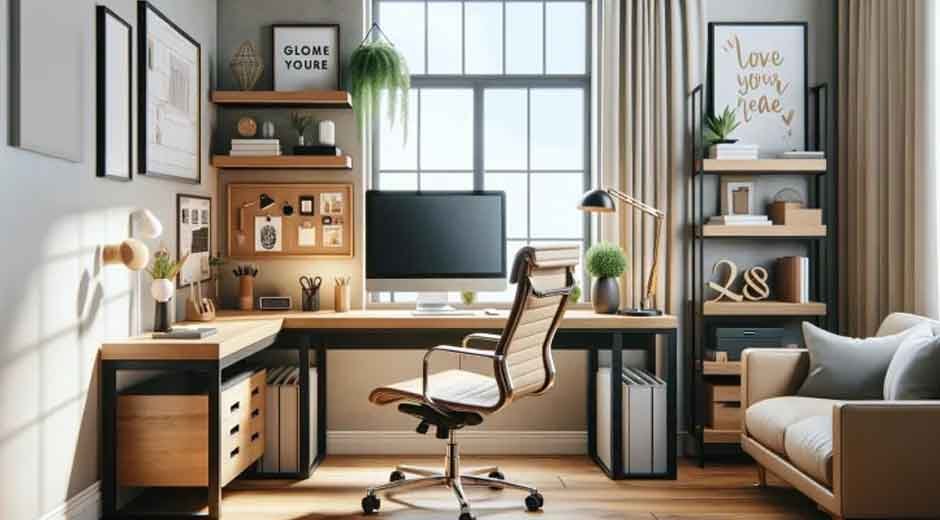A well-designed office is more than just a place to work—it’s a space that supports productivity, inspires creativity, and promotes well-being. Office comfort plays a vital role in how employees feel and perform during their workday. From ergonomic furniture to ambient lighting, every design choice impacts the overall work experience. In this post, we’ll explore the essentials of creating a comfortable office space and how thoughtful design can directly enhance productivity.
Table of Contents
1. Ergonomics: Supporting the Body
One of the most critical aspects of office comfort is ergonomics. Employees spend long hours seated at desks, so furniture that promotes good posture is essential. Adjustable chairs with lumbar support, sit-stand desks, and properly positioned monitors help reduce strain on the body.
Ergonomic setups prevent repetitive stress injuries, such as carpal tunnel syndrome and back pain, which can lead to absenteeism and decreased productivity. Employers should invest in quality furniture and encourage team members to customize their workstations to suit their individual needs.
2. Lighting: Setting the Right Mood
Lighting has a significant effect on mood, energy levels, and concentration. Harsh fluorescent lights can lead to eye strain and fatigue, while insufficient lighting can cause drowsiness and reduce alertness. The best office design incorporates natural light wherever possible. Large windows, skylights, and glass partitions allow daylight to flow into the space, creating a bright and inviting atmosphere.
When natural light isn’t available, use layered lighting—combining ambient, task, and accent lighting—to create a balanced and flexible environment. Warm light tones are ideal for comfort and relaxation, while cooler tones help with focus and alertness.
3. Temperature and Air Quality: Creating a Comfortable Climate
Maintaining a steady and comfortable indoor temperature is an often underestimated but essential factor in workplace comfort. Offices that are too warm or too chilly can lead to distractions, discomfort, and lower employee satisfaction. A properly functioning HVAC system is key to keeping the climate consistent year-round.
Equally important is maintaining good air quality. Poor ventilation can lead to fatigue, headaches, and respiratory problems, all of which negatively impact productivity. Adding air purifiers or incorporating indoor plants can help enhance air circulation and bring in fresh oxygen.
To ensure optimal performance and avoid unexpected issues, it’s important to schedule routine maintenance for heating and cooling systems. If you’re located in the area, professional AC repair in Cottonwood Heights can help keep your system running efficiently and your office environment comfortable no matter the season.
4. Noise Control: Enhancing Focus
Sound plays a major role in workplace comfort. Excessive noise from open-plan offices, phone calls, or equipment can distract employees and lower productivity. Acoustic design solutions like sound-absorbing panels, carpets, ceiling tiles, and designated quiet zones can significantly reduce noise levels.
Offering private work areas or “focus pods” allows individuals to work without interruptions, while collaboration spaces can handle louder activities. Providing noise-canceling headphones can also be a helpful solution for workers who need to concentrate in open areas.
5. Aesthetics and Layout: Boosting Morale
A visually appealing office contributes to employee happiness and motivation. Colors, textures, and décor all influence how people feel in a space. Soft, natural colors promote calmness, while vibrant tones can energize and inspire.
An open layout encourages collaboration, but it should also include quiet zones and break rooms to cater to different working styles. Green spaces, artwork, and comfortable lounges create a welcoming, human-centric environment. When employees enjoy the atmosphere, they are more likely to be engaged and productive.
6. Break Areas and Amenities: Encouraging Balance
Comfort isn’t limited to the desk. Break rooms, cafeterias, and relaxation zones give employees a chance to recharge. Providing cozy seating, healthy snacks, and recreational options—such as games or reading materials—can boost morale and foster a sense of community.
Amenities like coffee stations, fitness rooms, or nap pods signal to staff that their well-being matters. When workers feel valued, they are more likely to stay loyal and put forth their best effort.
7. Personalization: Making It Feel Like Home
Allowing employees to personalize their workspace adds a sense of ownership and comfort. Simple touches like family photos, personal mugs, or favorite plants can make a big difference in how someone feels at work.
Managers should encourage team members to create a space that reflects their personality while still maintaining a clean and organized environment. This balance between personal comfort and professionalism contributes to overall satisfaction.
In Conclusion
Comfort and productivity are deeply connected. When office design prioritizes employee well-being, the entire organization benefits. From ergonomic furniture to soothing aesthetics and thoughtful amenities, creating a comfortable office is an investment in your team’s performance and happiness.
By focusing on these comfort essentials, businesses can cultivate a workspace that not only looks good but also feels right—transforming the office into a hub of productivity, creativity, and well-being.
